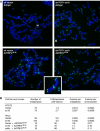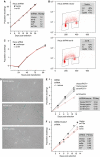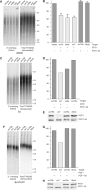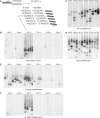POT1 protects telomeres from a transient DNA damage response and determines how human chromosomes end
- PMID: 15973431
- PMCID: PMC1176460
- DOI: 10.1038/sj.emboj.7600733
POT1 protects telomeres from a transient DNA damage response and determines how human chromosomes end
Abstract
The hallmarks of telomere dysfunction in mammals are reduced telomeric 3' overhangs, telomere fusions, and cell cycle arrest due to a DNA damage response. Here, we report on the phenotypes of RNAi-mediated inhibition of POT1, the single-stranded telomeric DNA-binding protein. A 10-fold reduction in POT1 protein in tumor cells induced neither telomere fusions nor cell cycle arrest. However, the 3' overhang DNA was reduced and all telomeres elicited a transient DNA damage response in G1, indicating that extensive telomere damage can occur without cell cycle arrest or telomere fusions. RNAi to POT1 also revealed its role in generating the correct sequence at chromosome ends. The recessed 5' end of the telomere, which normally ends on the sequence ATC-5', was changed to a random position within the AATCCC repeat. Thus, POT1 determines the structure of the 3' and 5' ends of human chromosomes, and its inhibition generates a novel combination of telomere dysfunction phenotypes in which chromosome ends behave transiently as sites of DNA damage, yet remain protected from nonhomologous end-joining.
Figures






References
-
- Bailey SM, Cornforth MN, Kurimasa A, Chen DJ, Goodwin EH (2001) Strand-specific postreplicative processing of mammalian telomeres. Science 293: 2462–2465 - PubMed
-
- Baird DM, Rowson J, Wynford-Thomas D, Kipling D (2003) Extensive allelic variation and ultrashort telomeres in senescent human cells. Nat Genet 33: 203–207 - PubMed
-
- Baumann P, Cech TR (2001) Pot1, the putative telomere end-binding protein in fission yeast and humans. Science 292: 1171–1175 - PubMed
Publication types
MeSH terms
Substances
Grants and funding
LinkOut - more resources
Full Text Sources
Molecular Biology Databases
Research Materials

